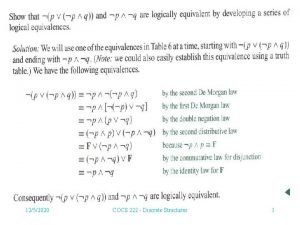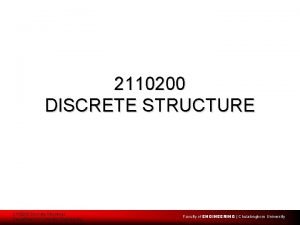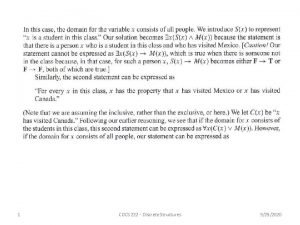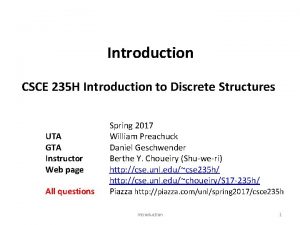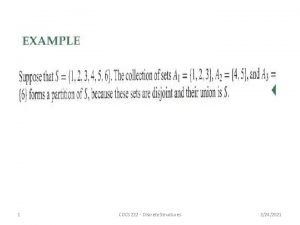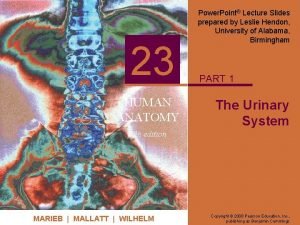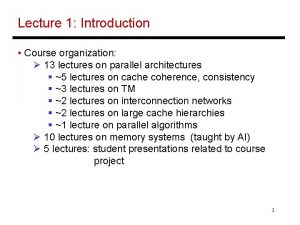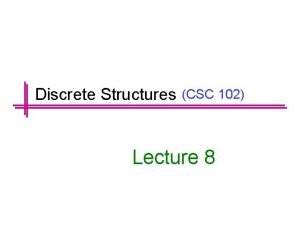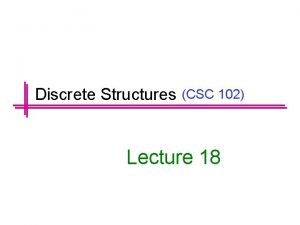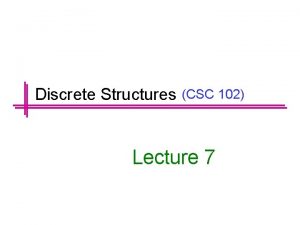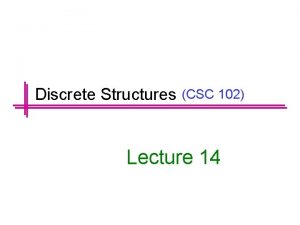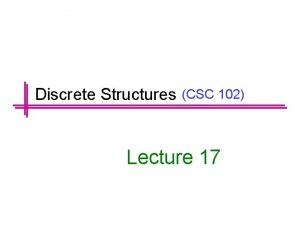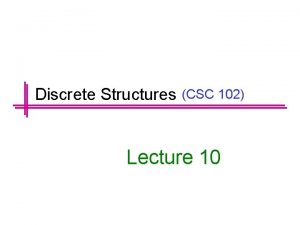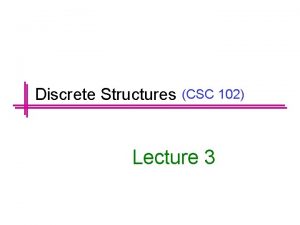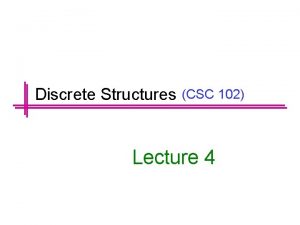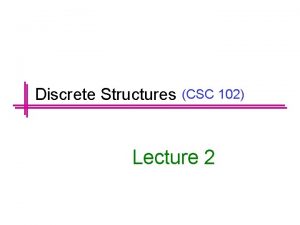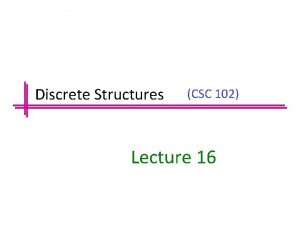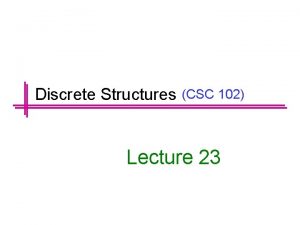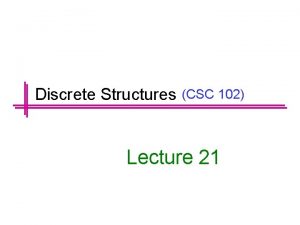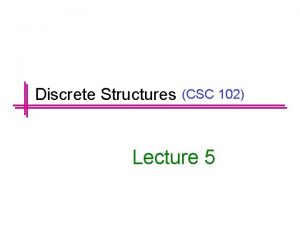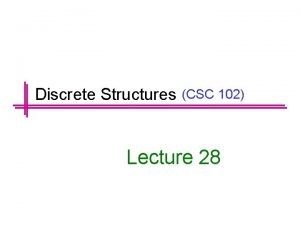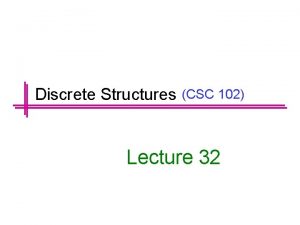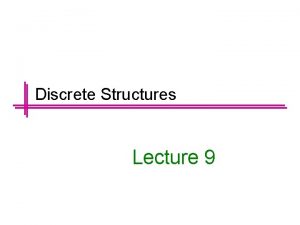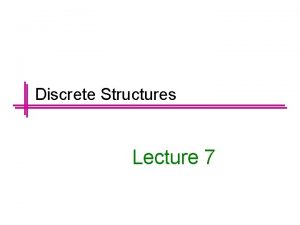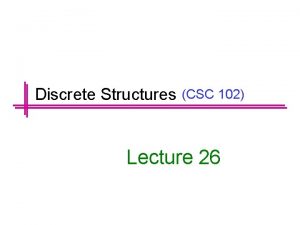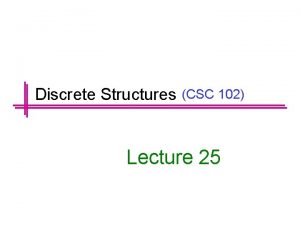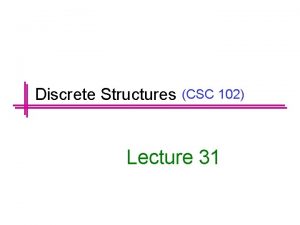Discrete Structures CSC 102 Lecture 9 Previous Lectures




























- Slides: 28

Discrete Structures (CSC 102) Lecture 9

Previous Lectures Summary • Statements containing “∀ ” and “∃” • Nested Quantifiers • Relations • Universal Instantiation statement • Universal Modus Ponens • Universal Modus Tollens • Quantified form of Converse and Inverse error

Elementary Number Theory

Today's Lecture • Divisors • Prime Numbers • Fundamental Theorem of Arithmetic • Division Algorithm • Greatest common divisors • Least Common Multiple • Relative Prime

Divisors DEF: Let a, b and c be integers such that a = b·c Then b and c are said to divide (or are factors) of a, while a is said to be a multiple of b (as well as of c). The pipe symbol “|” denotes “divides” so the situation is summarized by b | a c | a. NOTE: Symbolically if a and b are integers and k is not equal to zero, an integer such

Examples Which of the following is true? 1. 77 | 7 2. 7 | 77 3. 24 | 24 4. 0 | 24 5. 24 | 0 Solution 1. 77 | 7: false bigger number can’t divide smaller positive number 2. 7 | 77: true because 77 = 7 · 11 3. 24 | 24: true because 24 = 24 · 1 4. 0 | 24: false, 5. 24 | 0: true, 0 is divisible by every number (0=24· 0)

Formula for Number of Multiples up to given N How many positive multiples of 15 are less than 100? Answer: Just list them 15, 30, 45, 60, 75, 90. Therefore the answer is 6. How many positive multiples of 15 are less than 1, 000?

Cont… Listing is too much of a hassle. Since 1 out of 15 numbers is a multiple of 15, if 1, 000 were divisible by 15, answer would be exactly 1, 000/15. However, since 1, 000 isn’t divisible by 15, need to round down to the highest multiple of 15 less than 1, 000, so answer is remainder of 1, 000/15 In general: The number of d-multiples less than N is given as: {m Z+ | d |m and m N }.

Divisor Theorems Theorem: Let a, b, and c be integers. Then 1. a | b a| c a|(b + c ) 2. a| b. c 3. a| b b| c a| c. (Transitive Property) Examples 1. 17|34 17|170 17|204. 2. 17|340. 3. 6|12 12|144 6|144.

Proof of the Theorem In general, such statements are proved by starting from the definitions and manipulating to get the desired results. 1. a | b a| c a|(b + c ) Suppose a|b and a|c then by definition, there is a number m such that b = a·m and there is a number n such that c = a·n. So by adding b and c we get b+c = am+an = a(m+n)=a·k. So b+c = a·k so by definition of “|”, we will get that a|(b+c).

Cont…. 2. a| b → a| b∙c Suppose a|b. By definition, there is a number m such that b = a·m. Multiply both sides by c to get b∙c = a·m·c = a∙(m∙c ). Consequently, b∙c has been expressed as a times the integer m∙c so by definition of “|”, a|b∙c. 3. a| b b| c → a| c Suppose a|b. By definition, there is a number m such that b = a∙m and b|c means there is a number k such that c=b∙k. putting the value of b = a∙m in c = b∙k, we will get c = (a∙m)∙k =a∙(m∙k)=a∙n, where n=m∙k. so by definition of “|”, a|c. We call that property of the divisibility Transitive Property.

Definitions • An integer n is even if, and only if, n=2. k for some integer k. • An integer n is odd if and only if, n=2 k+1 for some integers k. • An integer n is prime if and only if n > 1 and for all positive integers r and s, if n=r. s, then r=1 or s=1. • An integer n is composite if and only if n=r. s for some positive integers r and s with r not equals to 1 and s not equals 1.

Prime Numbers DEF: A number n 2 is prime if it is only divisible by 1 and itself. A number n 2 which isn’t prime is called composite. Which of the following are prime? 0, 1, 2, 3, 4, 5, 6, 7, 8, 9. Answer: 0, and 1 not prime since not positive and greater or equal to 2. 2 is prime as 1 and 2 are only factors. 3 is prime as 1 and 3 are only factors. 4, 6, 8, 10 not prime as non-trivially divisible by 2. 5, 7 prime. 9 = 3 · 3 not prime. Last example shows that not all odd numbers are prime.

Fundamental Theorem of Arithmetic Statement: Any number n 2 is expressible as a unique product of 1 or more prime numbers. (Note: prime numbers are considered to be “products” of 1 prime. We’ll need induction and some more number theory tools to prove this). Example Express each of the following number as a product of primes: 22, 100, 12, 17. Answer: 22 = 2· 11, 100 = 2· 2· 5· 5, 12 = 2· 2· 3, 17 = 17

Cont… The prime factorizations of 100, 641, 999, and 1024 are given by Sol: 100 = 2*2*5*5. 641 = 641. 999 = 3*3*7. 1024 = 2*2*2*2*2*2.

Cont… Lemma: If n is a composite, then its smallest prime factor is Proof. Suppose the smallest prime factor is > . Then by the fundamental theorem of arithmetic we can decompose n = p. q. x where p and q are primes > and x is some integer. Therefore implying that n > n, which is impossible showing that the original supposition was false and theorem is correct. �

Cont…. Example: Test if 139 and 143 are prime. List all primes up to and check if they divide the numbers. 2: Neither is even 3: Sum of digits trick: 1+3+9 = 13, 1+4+3 = 8 so neither divisible by 3. 5: Don’t end in 0 or 5 7: 140 divisible by 7 so neither div. by 7 11: Alternating sum trick: 1 -3+9 = 7 so 139 not divisible. By 11. 1 -4+3 = 0 so 143 is divisible by 11. STOP! Next prime 13 need not be examined since bigger than Conclude: 139 is prime, 143 is composite.

Division Remember long division? d the divisor a the dividend 117 = 31· 3 + 24 a = d∙q + r q the quotient r the remainder

Division Algorithm Let a be an integer, and d be a positive integer. There are unique integers q, r with r {0, 1, 2, …, d-1} satisfying a = d∙q + r The proof is a simple application of long-division. This is called the division algorithm.

Example What are the quotient and remainder when -11 is divided by 3? Solution: We have -11=3(-4)+1. Hence, the quotient when -11 is divided by 3 is -4 = -11 div 3, and the remainder is 1 = -11 mod 3. Note that the remainder cannot be negative. Consequently, the remainder is not -2, even though -11 = 3(-3) - 2, because r = -2 does not satisfy 0 < r < 3. Note that the integer a is divisible by the integer d if and only if the remainder is zero when a is divided by d.

Greatest Common Divisor DEF: Let a, b be integers, not both zero. The greatest common divisor (or HCF) of a and b (or gcd (a , b) ) is the biggest number d which divides both a and b. Equivalently: gcd(a, b) is smallest number which divides any x dividing both a and b. DEF: a and b are said to be relatively prime if gcd(a, b) = 1, so no prime common divisors.

Example: Find the following gcd’s: 1. gcd(11, 77) 2. gcd(33, 77) 3. gcd(24, 36) 4. gcd(24, 25) Answer 1. 2. 3. 4. gcd(11, 77) = 11 gcd(33, 77) = 11 gcd(24, 36) = 12 gcd(24, 25) = 1. Therefore 24 and 25 are relatively prime. NOTE: A prime number is relatively prime to all other numbers which it doesn’t divide.

Examples Pair-wise relatively prime: The numbers a, b, c, d, … are said to be pair-wise relatively prime if any two distinct numbers in the list are relatively prime. Question: Find a pair-wise relatively prime subset of 44, 28, 21, 15, 169, 17 } Answer: A maximal pair-wise relatively prime subset of {44, 28, 21, 15, 169, 17} : {17, 169, 28, 15} is one answer. {17, 169, 44, 15} is another answer. {

Least Common Multiple The least common multiple of a, and b (or lcm(a, b) ) is the smallest number m which is divisible by both a and b. Equivalently: lcm(a , b) is biggest number which divides any x divisible by both a and b. Find the lcm’s: 1. 2. 3. lcm(10, 100) lcm(7, 5) lcm(9, 21) Answer 1. 2. 3. lcm(10, 100) = 100 lcm(7, 5) = 35 lcm(9, 21) = 63

L. C. M in terms of G. C. D Theorem: lcm(a, b) = (a∙b) / gcd(a, b), Proof. Let g = gcd(a, b). Factor a and b using g: a = g. x, b = g. y where x and y are relatively prime. Therefore, a. b/gcd(a, b) = (g. x. g. y)/g = g. x. y. Notice that a and b both divide g. x. y. On the other hand, let m be divisible by both a and b. So m/g is divisible by both x and y. As x and y have no common prime factors, the fundamental theorem of arithmetic implies that m/g must be divisible by x. y.

Cont… m/g must be divisible by x·y. Therefore, m must be divisible by g. x. y. This shows that any multiple of a and b is bigger than g. x. y so by definition, g. x. y = a. b/gcd(a, b) is the lcm. Example lcm(10, 15)=30, gcd(10, 15)=5, (10*15)/5=30.

Importance of Number Theory Before the dawn of computers, many viewed number theory as last bastion of “pure math” which could not be useful and must be enjoyed only for its aesthetic beauty. No longer the case. Number theory is crucial for encryption algorithms. Of utmost importance to everyone from Bill Gates, to the CIA, to Osama Bin Laden. Check out Angelos Keromytis's lecture--www. cs. columbia. edu/~angelos/teaching/lecture 8/index. html ---from COMS 4180 “Network Security” in which he applies number theory to encryption.

Lecture Summary • Divisors • Prime Numbers • Fundamental Theorem of Arithmetic • Division Algorithm • Greatest common divisors. • Least Common Multiple • Relative Prime
 Csc 102 pdf
Csc 102 pdf 01:640:244 lecture notes - lecture 15: plat, idah, farad
01:640:244 lecture notes - lecture 15: plat, idah, farad What is tautology in math
What is tautology in math Discrete structures
Discrete structures Discrete structures
Discrete structures Cs 584
Cs 584 Webhandin unl
Webhandin unl Discrete structures
Discrete structures Discrete computational structures
Discrete computational structures Example of homologous structure
Example of homologous structure Oral communication 3 lectures text
Oral communication 3 lectures text Tamara berg husband
Tamara berg husband Translation 1
Translation 1 Web engineering lectures ppt
Web engineering lectures ppt Anatomy lectures powerpoint
Anatomy lectures powerpoint Ota resident lectures
Ota resident lectures Trend lectures
Trend lectures 13 lectures
13 lectures Nuclear medicine lectures
Nuclear medicine lectures Advanced medicinal chemistry
Advanced medicinal chemistry Introduction to recursion
Introduction to recursion Radio astronomy lectures
Radio astronomy lectures Pathology lectures for medical students
Pathology lectures for medical students Hematology medicine student lectures
Hematology medicine student lectures C programming and numerical analysis an introduction
C programming and numerical analysis an introduction Power system lectures
Power system lectures Rick trebino lectures
Rick trebino lectures Digital logic design lectures
Digital logic design lectures Do words have power
Do words have power



